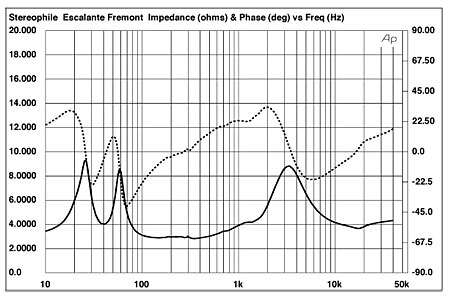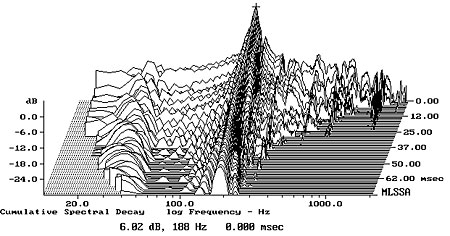| Columns Retired Columns & Blogs |
Escalante Design Fremont loudspeaker Measurements
Sidebar 3: Measurements
As LG noted, the Escalante Fremont is considerably more sensitive than the norm, my estimate (measured on the tweeter axis) coming in at 92.5dB/2.83V/m. This is within experimental error of the specified 93dB. However, the speaker's impedance is significantly lower than specified, falling to 3 ohms for the entire midrange and remaining between 4 and 6 ohms for much of the rest of the audioband, which, in combination with a relatively large electrical phase angle some of the time, suggests that the Fremont will need a high-current amplifier to play at its loudest.
There are small discontinuities in the impedance traces at 190 and 300Hz, which implies the existence of cabinet resonances of some kind at these frequencies. Testing for the presence of resonances with a simple accelerometer, I found a high-amplitude mode present on the sidewall in the center of the black section at 188Hz (fig.2). This mode was also present on the top panel, along with a fairly strong resonance at 400Hz, but at 300Hz all panels were free from anything untoward. This behavior may look worse than it sounds; with a speaker of very high sensitivity, the output from the drive-units will be very much louder than that from the panels, compared with a speaker having similar-level resonances but lower sensitivity.

Fig.1 Escalante Fremont, electrical impedance (solid) and phase (dashed). (2 ohms/vertical div.)
The saddle in the impedance magnitude plot (fig.1) was centered at 40Hz, suggesting that this is the tuning frequency of the twin rectangular ports. This is close to the frequency of the lowest string of the four-string double bass or electric bass guitar, which in turn suggests only modest low-frequency extension for such a large loudspeaker. (For a given cabinet size, voltage sensitivity is traded off against bass extension.) But as shown by the nearfield responses plotted in fig.3, the port's maximum output actually occurs a little higher than 40Hz (red trace), while the minimum-motion point in the isobaric-loaded woofers' output (blue) occurs a little lower. The complex sum of the port and woofer outputs (fig.3, black) peaks in the midbass, then rolls off below 50Hz with the 24dB/octave slope typical of a reflex design. As Larry Greenhill noted, the Fremont's measured low-frequency output is not as high in level as its appearance might lead one to expect.

Fig.2 Escalante Fremont, cumulative spectral-decay plot calculated from the output of an accelerometer fastened to the center of the black section of side panel (MLS driving voltage to speaker, 7.55V; measurement bandwidth, 2kHz).

Fig.3 Escalante Fremont, anechoic response without grille on tweeter axis, averaged across 30° horizontal window and corrected for microphone response, with nearfield responses of the woofers (blue) and ports (red), plotted in the ratios of the square roots of their radiating areas, and the complex sum of the nearfield responses plotted below 300Hz (black).
There are sharply defined antiresonances in the woofer's nearfield response at 210 and 300Hz, the latter coinciding with the wrinkle at the same frequency in the impedance traces. The Fremont's upper midrange, measured on the tweeter axis, is flat, but a large suckout appears in the mid-treble, with then the tweeter operating around 5dB lower in level than is required for true neutrality. LG did say that he found that the Fremont didn't sound fatiguing at high levels, which, I suggest, is characteristic of this kind of response.
A suckout like this generally results from the change in acoustic phase in the crossover region in the drive signals not being accounted for in the polarity or the physical placement of the two drive-units. In which case, there will be a vertical axis where the two drive-unit outputs do add in phase to give a flat response through this region. But as fig.4 reveals, the treble suckout remains evident across a wide range of vertical listening positions. The tweeter is mounted too far forward of the radiating center of the woofer array to integrate properly with it, I feel.

Fig.4 Escalante Fremont, vertical response family at 50", normalized to response on tweeter axis, from back to front: differences in response 15–5° above axis, reference response, differences in response 5–10° below axis.
Fig.5 shows the speaker's response family to the sides of the tweeter axis. Despite the contribution of its dustcap, the large-diameter compound woofer gets quite directional above 1500Hz, above which the lack of energy in the crossover region makes its presence known. As the tweeter is recessed in the wide baffle, it gets increasingly directional above 8kHz or so. More importantly, if I normalize all the responses to the tweeter-axis behavior (fig.6), it becomes evident that the crossover-region suckout tends to fill in to the Fremont's sides. In large, reverberant rooms, particularly if the listener sits a long way back from the speakers, this measured problem may well look worse than it will sound. I therefore drove up to Larry's home to measure the Fremonts in his room, to further explore this aspect of their behavior.

Fig.5 Escalante Fremont, lateral response family at 50", from back to front: responses 90–5° off axis, reference response, responses 5–90° off axis.

Fig.6 Escalante Fremont, lateral response family at 50", normalized to response on tweeter axis, from back to front: differences in response 90–5° off axis, reference response, differences in response 5–90° off axis.
Fig.7 shows the spatially averaged response of the Escalantes, calculated by taking 18 1/6-octave-smoothed responses for each speaker individually in a 48"-by-18" vertical rectangular grid centered on the position of Larry's ears in his listening chair. (I used SMUG Software's Fuzzmeasure program running on my Apple PowerBook, in conjunction with a Metric Halo ULN-2 and a calibrated EarthWorks QTC-40 microphone.) Even with the support offered by the room's boundaries, the low frequencies roll off rapidly below 55Hz or so. The "floor-bounce" dip in the lower midrange is deeper than usual and thrown into contrast by the elevated upper midrange. Despite the lateral dispersion tending to compensate for the crossover suckout, it is still very much in evidence at Larry's listening seat, which is just under 8' from the speakers. An in-room measurement will present a speaker's high treble as being smoothly rolled-off, due to the increased absorption of furnishings in this region. However, the Fremonts' output above 5kHz is definitely shelved-down, as predicted by the on-axis, quasi-anechoic response (fig.3). Both speakers measured similarly in this respect.

Fig.7 Escalante Fremont, spatially averaged, 1/6-octave response in LG's listening room.
Turning to the time domain, the Fremont's step response on the tweeter axis (fig.8) reveals that both units are connected in positive acoustic polarity but, as mentioned above, the tweeter's output leads that of the woofers too much for good frequency-response integration in the crossover region. The cumulative spectral-decay plot on the tweeter axis (fig.9) is very clean in the region covered by the tweeter, but is dominated not only by the lack of energy in the crossover region, but also by some resonant modes in the upper midrange. These, in conjunction with the raised upper-midrange and depressed lower treble, could lead to the nasality Larry found audible with speaking voices and the coloration he noted on piano.

Fig.8 Escalante Fremont, step response on tweeter axis at 50" (5ms time window, 30kHz bandwidth).

Fig.9 Escalante Fremont, cumulative spectral-decay plot at 50" (0.15ms risetime).
If good looks conferred equally good sound on a loudspeaker, the Escalante Fremont would be a winner. But while it offers both a very high sensitivity and well-defined, if ultimately lightweight low frequencies, its measured problems in the midrange preclude a recommendation, in my opinion.— John Atkinson
- Log in or register to post comments




































